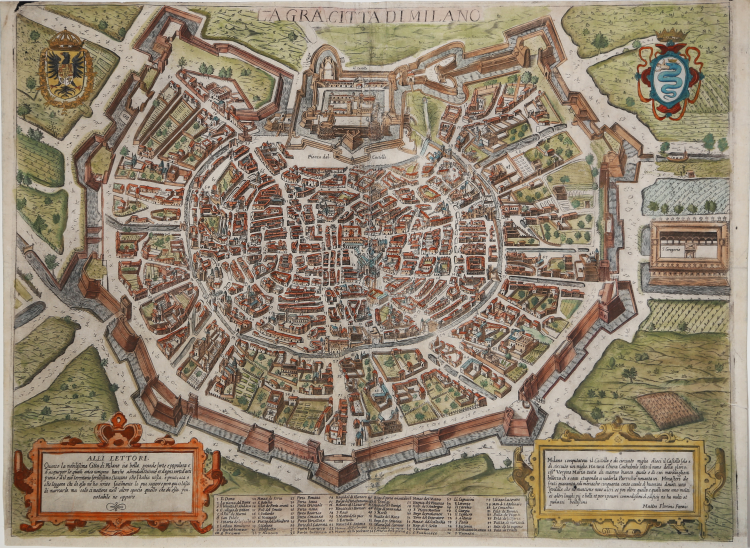



| Reference: | S40324 |
| Author | Matteo FLORIMI |
| Year: | 1600 ca. |
| Zone: | Milan |
| Measures: | 540 x 405 mm |


| Reference: | S40324 |
| Author | Matteo FLORIMI |
| Year: | 1600 ca. |
| Zone: | Milan |
| Measures: | 540 x 405 mm |
At top center, the title LA GRA[N] CITTA DI MILANO. Upper left the imperial coat of arms of the Hapsburgs, at the top right the Visconti bison used as the coat of arms of the city of Milan. In the cartouche in the lower left corner: ALLI LETTORI. Quanto la nobilissima Città di Milano sia bella grande forte e populata e d’acque per le quali anco vengono barche abondantissime et d’ogni sorti d’arti piena, e d’il suo territorio fertilissimo. Ciascuno che l’habia vista, o praticata, o che leggera chi di essa ne ha scritto facilmente lo puo sapere e pero qui si lassa di narrarlo, ma solo si mettera nell’altro spatio quello che di essa più notabile ne appare. Nel cartiglio in basso a destra: Milano computatovi il Castello è di circuito miglia dieci il Castello solo è di circuito un miglio. Ha una Chiesa Cathedrale sotto il nome della gloriosiss.a Vergine Maria tutta di marmo bianco quale e di cosi maravigliosa bellezza ch’è cosa stupenda a vederla. Parrochie novantasei. Monasteri de frati quaranta, e di monache cinquanta, cento scuole d’huomini devoti, uno spedale, che ne mantiene nove altri, et poi oltre quello, e quelli, vene sono molti et altri luoghi pij e belli, et per i poveri commodissimi d’edificij ne ha molti et palazzi bellissimi. Followed by the imprint Matteo Florimi Formis.
Along the lower margin, in the center, is engraved a numerical legend of 86 references to places and monuments notable, on nine columns.
This is the last sixteenth-century replica of Lafreri's plan and is signed by Matteo Florimi. Like the original by Lafreri, it describes Milan during the Spanish domination, after the building renovations, in particular of the castle and the fortifications, carried out under the governor Ferrante Gonzaga. The new wall of bastions, with nine doors, is composed of ten sides of different lengths No reprints are known, but some copies of the map, of later printing, can be attributed to Pietro Petrucci, who acquired most of the plates of Florimi.
Etching and engraving, printed on contemporary laid paper, minimal restoration to the central fold and some abrasions visible on the verso, otherwise in good condition. Finely hand-colored. Rare.
Bibliography
Bifolco-Ronca, Cartografia e topografia italiana del XVI Secolo (2018): p. 2236, Tav. 1144; Cartografia Rara (1986): n. 87; Christie’s (2011): n. 33; Shirley (2004): III, n. 39; Arrigoni-Bertarelli (1931): n. 991; Boffa (2013): II, n. 10; Gambi-Gozzoli: p. 350, n. 16; Van der Heijden (1993): n. 30; Lago (2002): p. 337, fig. 328; Tooley (1983): n. 390c.
Matteo FLORIMI (Polistena 1540 circa - Siena 1613)
|
Print and book dealer and publisher, from Calabria. He came to Siena c.1581.Shop in Banchi. The first evidence of his independent activity is of 1589. In 1591 he published a book of patterns for lace, The Fiori di ricami, in Venice, and in 1593 a second edition in Siena.
In 1597 he published the Life of St Catherine, engraved by De Jode after Vanni, and the Passion of Christ by De Jode after Andrea Boscoli. He published a large number of maps and figural prints are mostly religious. He employed engravers of the calibre of Agostino Carracci, Cornelis Galle, Pieter de Jode Villamena and Thomassin, among others.
He commissioned drawings from Andrea Boscoli. He had a particularly close relationship with Vanni. In the years 1605-8, Florimi received financial support from Ottavio Cinuzzi.
|
Matteo FLORIMI (Polistena 1540 circa - Siena 1613)
|
Print and book dealer and publisher, from Calabria. He came to Siena c.1581.Shop in Banchi. The first evidence of his independent activity is of 1589. In 1591 he published a book of patterns for lace, The Fiori di ricami, in Venice, and in 1593 a second edition in Siena.
In 1597 he published the Life of St Catherine, engraved by De Jode after Vanni, and the Passion of Christ by De Jode after Andrea Boscoli. He published a large number of maps and figural prints are mostly religious. He employed engravers of the calibre of Agostino Carracci, Cornelis Galle, Pieter de Jode Villamena and Thomassin, among others.
He commissioned drawings from Andrea Boscoli. He had a particularly close relationship with Vanni. In the years 1605-8, Florimi received financial support from Ottavio Cinuzzi.
|